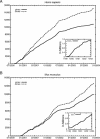The status, quality, and expansion of the NIH full-length cDNA project: the Mammalian Gene Collection (MGC)
- PMID: 15489334
- PMCID: PMC528928
- DOI: 10.1101/gr.2596504
The status, quality, and expansion of the NIH full-length cDNA project: the Mammalian Gene Collection (MGC)
Erratum in
- Genome Res. 2006 Jun;16(6):804. Morrin, Ryan [corrected to Morin, Ryan]
Abstract
The National Institutes of Health's Mammalian Gene Collection (MGC) project was designed to generate and sequence a publicly accessible cDNA resource containing a complete open reading frame (ORF) for every human and mouse gene. The project initially used a random strategy to select clones from a large number of cDNA libraries from diverse tissues. Candidate clones were chosen based on 5'-EST sequences, and then fully sequenced to high accuracy and analyzed by algorithms developed for this project. Currently, more than 11,000 human and 10,000 mouse genes are represented in MGC by at least one clone with a full ORF. The random selection approach is now reaching a saturation point, and a transition to protocols targeted at the missing transcripts is now required to complete the mouse and human collections. Comparison of the sequence of the MGC clones to reference genome sequences reveals that most cDNA clones are of very high sequence quality, although it is likely that some cDNAs may carry missense variants as a consequence of experimental artifact, such as PCR, cloning, or reverse transcriptase errors. Recently, a rat cDNA component was added to the project, and ongoing frog (Xenopus) and zebrafish (Danio) cDNA projects were expanded to take advantage of the high-throughput MGC pipeline.
Figures


References
-
- Adams, M.D., Kelley, J.M., Gocayne, J.D., Dubnick, M., Polymeropoulos, M.H., Xiao, H., Merril, C.R., Wu, A., Olde, B., Moreno, R.F., et al. 1991. Complementary DNA sequencing: Expressed sequence tags and Human Genome Project. Science 252: 1651-1656. - PubMed
-
- Anant, S., Blanc, V., and Davidson, N.O. 2003. Molecular regulation, evolutionary, and functional adaptations associated with C to U editing of mammalian apolipoproteinB mRNA. Prog. Nucleic Acid Res. Mol. Biol. 75: 1-41. - PubMed
-
- Bamshad, M. and Wooding, S.P. 2003. Signatures of natural selection in the human genome. Nat. Rev. Genet. 4: 99-111. - PubMed
-
- Boguski, M.S., Lowe, T.M., and Tolstoshev, C.M. 1993. dbEST—Database for “expressed sequence tags.” Nat. Genet. 4: 332-333. - PubMed
WEB SITE REFERENCES
-
- http://cgap.nci.nih.gov; Cancer Genome Anatomy Project.
-
- http://genome.ucsc.edu; UCSC Genome Browser.
-
- http://image.llnl.gov/image/html/vectors.shtml; complete sequence for each of the MGC vectors.
-
- http://mgc.nci.nih.gov; MGC.
-
- http://www.ebi.ac.uk/embl/indiex.html; chimpanzee.
Publication types
MeSH terms
Substances
Grants and funding
LinkOut - more resources
Full Text Sources
Other Literature Sources
Molecular Biology Databases
Research Materials
